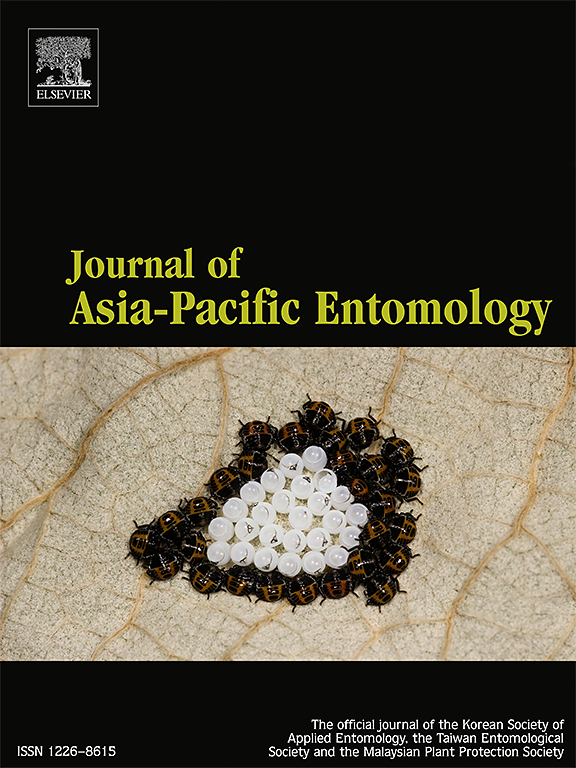Description of a new species of Phymastichus (Hymenoptera: Eulophidae), a parasitoid of adult shothole borers Euwallacea spp. (Coleoptera: Curculionidae) in Asia
IF 1.1
3区 农林科学
Q3 ENTOMOLOGY
引用次数: 0
Abstract
Phymastichus nudusdraco Triapitsyn & Rugman-Jones, sp. n. (Hymenoptera: Eulophidae: Tetrastichinae) is described and illustrated based on the type series from Taiwan and reared specimens from quarantine colonies of Taiwan origin. This species, which is also known from Thailand, is a solitary parasitoid of adult shothole borers Euwallacea spp. (Coleoptera: Curculionidae: Scolytinae) in Asia. In Taiwan, its confirmed hosts are E. fornicatus (Eichhoff) and E. kuroshio Gomez & Hulcr, and as such, in the USA it is being evaluated under quarantine conditions as a potential classical biological control agent against these two invasive species in southern California. In Thailand, the known host of P. nudusdraco is a third shothole borer species, E. perbrevis (Schedl), which has invaded the U.S. states of Florida and Hawaiʻi. Unambiguous supporting molecular evidence for separation of the four named species of the genus Phymastichus LaSalle is provided. Although there is a slight but consistent difference in the coloration of legs in female P. nudusdraco specimens from Taiwan and Thailand, genetically, these are sufficiently similar to confirm conspecificity.

文章标题亚洲小圆孔蝇成虫(鞘翅目:小圆孔蜂科)寄生蜂一新种记述
棘球棘球龙&;本文以台湾产的蜂类和台湾检疫群饲养的标本为基础,对鲁格曼-琼斯(Rugman-Jones, sp. n.)(膜翅目:蜂科:四蜂科)进行了描述和说明。本种产于泰国,是一种独居的寄生于亚洲的小孔螟成虫(鞘翅目:小孔螟科:小孔螟科)。在台湾,它的确认宿主是E. fornicatus (Eichhoff)和E. kuroshio Gomez &;因此,在美国,它正在检疫条件下作为一种潜在的经典生物防治剂,在南加州对抗这两种入侵物种。在泰国,已知的P. nudusdraco宿主是第三种孔虫,E. perbrevis (Schedl),它已经入侵了美国佛罗里达州和夏威夷。本文提供了四个已命名种的分离的明确的分子支持证据。尽管在台湾和泰国的雌性裸爪龙标本中,腿的颜色有轻微但一致的差异,但遗传学上,这些相似性足以确认同一性。
本文章由计算机程序翻译,如有差异,请以英文原文为准。
求助全文
约1分钟内获得全文
求助全文
来源期刊

Journal of Asia-pacific Entomology
Agricultural and Biological Sciences-Insect Science
CiteScore
2.70
自引率
6.70%
发文量
152
审稿时长
69 days
期刊介绍:
The journal publishes original research papers, review articles and short communications in the basic and applied area concerning insects, mites or other arthropods and nematodes of economic importance in agriculture, forestry, industry, human and animal health, and natural resource and environment management, and is the official journal of the Korean Society of Applied Entomology and the Taiwan Entomological Society.
 求助内容:
求助内容: 应助结果提醒方式:
应助结果提醒方式:


